Subaru Forester: Towing
If towing is necessary, it is best done by your SUBARU dealer or a commercial towing service. Observe the following procedures for safety.
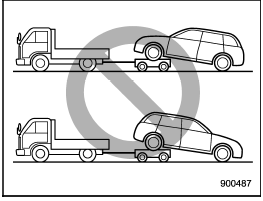

Never tow AWD models (both AT and MT) with the front wheels raised off the ground while the rear wheels are on the ground, or with the rear wheels raised off the ground while the front wheels are on the ground.
This will cause the vehicle to spin away due to the operation or deterioration of the center differential.
Towing and tie-down hooks
The towing hooks should be used only in an emergency (e.g., to free a stuck vehicle from mud, sand or snow).

- Use only the specified towing hook and tie-down hook. Never use suspension parts or other parts of the body for towing or tie-down purposes.
- To prevent deformation to the front bumper and the towing hook, do not apply excessive lateral load to the towing hook.
Front towing hook:
1. Take the towing hook out of the tool bucket and take the screwdriver out of the tool bag. Take the wheel nut wrench out of the cargo area.
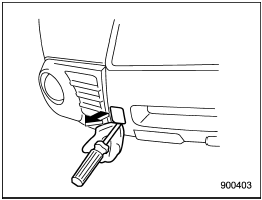
2. Pry off the cover on the front bumper using a screwdriver, and you will find a threaded hole for attaching the towing hook.
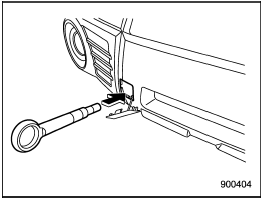
3. Screw the towing hook into the thread hole until its thread can no longer be seen.
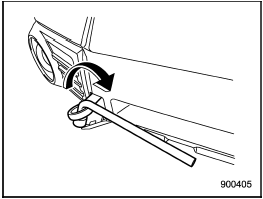
4. Tighten the towing hook securely using a wheel nut wrench.
After towing, remove the towing hook from the vehicle and stow it in the tool bucket.
Fit the towing hook cover on the bumper.

- Do not use the towing hook except when towing your vehicle.
- Be sure to remove the towing hook after towing. Leaving the towing hook mounted on the vehicle could interfere with proper operation of the SRS airbag system in a frontal collision.
Rear towing hook:

If a trailer hitch is installed, it is not possible to install the rear towing hook.
To install the rear towing hook, the standard bumper beam must be installed on the vehicle at a SUBARU dealer. Consult a SUBARU dealer for details.
Use a hitch ball and follow the instructions below when towing.
- The weight of the object being towed must be less than the weight of the vehicle.
- Drive the vehicle 20 mph (32 km/h) or less speed.
- Do not drive more than 31 miles (50 km).
1. Take the towing hook out of the tool bucket and take the screwdriver out of the tool bag. Take the wheel nut wrench out of the cargo area.
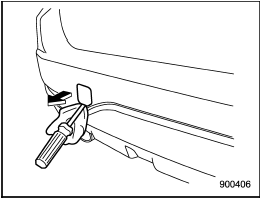
2. Pry off the cover on the rear bumper using a screwdriver, and you will find a threaded hole for attaching the towing hook.
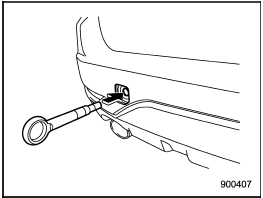
3. Screw the towing hook into the thread hole until its thread can no longer be seen.
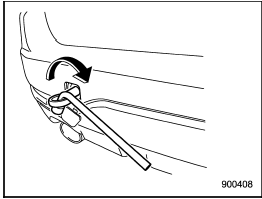
4. Tighten the towing hook securely using a wheel nut wrench.
After towing, remove the towing hook from the vehicle and stow it in the tool bucket.
Fit the towing hook cover on the bumper.

Do not use the towing hook except when towing your vehicle.
Front tie-down hooks:
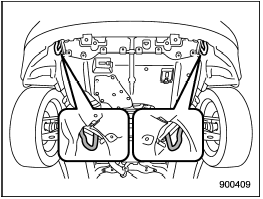
The front tie-down hooks are located between each of the front tires and the front bumper.
Rear tie-down hooks:
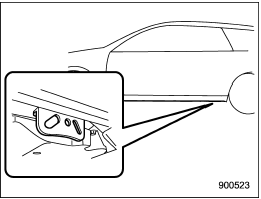
The rear tie-down hooks are located near each of the jack-up reinforcements.

Use the rear tie-down hooks only for downward anchoring. If they are used to anchor the vehicle in any other direction, cables may slip off the hooks, possibly causing a dangerous situation.
Using a flat-bed truck
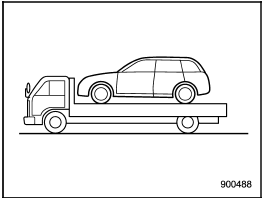
This is the best way to transport your vehicle. Use the following procedures to ensure safe transportation.
1. Shift the select lever into the “P” position for automatic transmission models or “1st” for manual transmission models.
2. Pull up the parking brake lever firmly.
3. Secure the vehicle onto the carrier properly with safety chains. Each safety chain should be equally tightened and care must be taken not to pull the chains so tightly that the suspension bottoms out.

If your vehicle has a front underspoiler and rear underspoiler (if equipped), be careful not to scrape them when placing the vehicle on the carrier and when removing the vehicle from the carrier.
Towing with all wheels on the ground
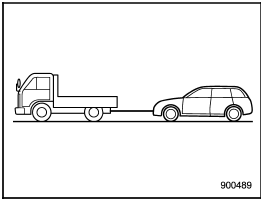
1. Release the parking brake and put the transmission in neutral.
2. The ignition switch should be in the “Acc” position while the vehicle is being towed.
3. Take up slack in the towline slowly to prevent damage to the vehicle.

- Never turn the ignition switch to the “LOCK” position while the vehicle is being towed because the steering wheel and the direction of the wheels will be locked.
- Remember that the brake booster and power steering do not function when the engine is not running. Because the engine is turned off, it will take greater effort to operate the brake pedal and steering wheel.

- If transmission failure occurs, transport your vehicle on a flatbed truck.
- Do not run the engine while being towed using this method. Transmission damage could result if the vehicle is towed with the engine running.
- For models with automatic transmission, the traveling speed must be limited to less than 20 mph (30 km/h) and the traveling distance to less than 31 miles (50 km). For greater speeds and distances, transport your vehicle on a flat-bed truck.
See also:
Engine Hood
Engine Hood
To open the engine hood: 1) Pull the hood release handle located on the outboard
side of the driver’s side of the instrument panel. This will disengage the engine
hood lock halfway.
2) Push the under-hood release lever sideways ...
Winter driving
The more severe weather conditions of winter
result in greater wear and other problems. To
minimize the problems of winter driving, you
should follow these suggestions:
Snowy or Icy Conditions
To drive your vehicle in deep snow, it may be
n ...

 Engine overheating
Engine overheating